2.1 Medical Gas
Everything that a respiratory therapist does is in some way tied to the delivery or titration of medical gasses. The storage, transport, and delivery of gasses both in the hospital and in the homes of patients are essential to the field of respiratory therapy.
Oxygen therapy supports life and supports combustion; however, it is not flammable. While there are many benefits to inhaled oxygen, there are also hazards and side effects. Anyone involved in the administration of oxygen should be aware of potential hazards and side effects of this medication. Oxygen should be administered cautiously and according to the safety guidelines.
Oxygen Safety Guidelines
When helping patients with oxygen, you should follow these guidelines:
- Remind patients that oxygen is a medication and should not be adjusted without consultation with a physician or respiratory therapist.
- When using oxygen cylinders, store them upright, chained, or in appropriate holders so that they will not fall over (see Figure 3[1]).
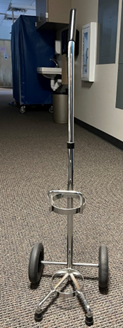
Figure 3. Oxygen tank cylinder holder. - Do not smoke around any oxygen delivery devices in the hospital or home environment because oxygen supports combustion.
- Keep oxygen delivery systems away from any heat source.
- Push oxygen tank cylinders instead of pulling them.
- Check for electrical hazards in the home or hospital prior to use. Determine that electrical equipment in the room or home is in safe working condition. A small electrical spark in the presence of oxygen will result in a serious fire. The use of a gas stove, kerosene space heater, or smoker is unsafe in the presence of oxygen. Avoid items that may create a spark (e.g., electrical razor, hair dryer, synthetic fabrics that cause static electricity, or mechanical toys) with nasal cannula in use.
- Check oxygen levels of portable tanks before transporting a patient to ensure that there is enough oxygen in the tank.
- Closely monitor high concentrations of oxygen therapy with formal assessment such as pulse oximetry and arterial blood gasses (ABGs).[2]
Oxygen Cylinder Facts
- O2 Concentration: Varies depending on the type and the quality of the source (e.g., 99.9% if filled from liquid oxygen [LOX]; 94% if filled from low-quality source).
- Distribution: Can be placed at the bedside (secured) or connected to a manifold pipeline distribution system.
- Capacity: Wide range of sizes, ranging from 100-10,000L (gaseous) capacity (see Figure 4[3]).
- Costs: Moderate cost (e.g., $60-$250) for the “E” cylinder but also requires regulator, flowmeter, and delivery; ongoing costs can be high, including cylinder deposit or leasing fee, refill costs, and transport costs.
- Labels: All cylinders come with a standard oxygen label, which includes items such as manufacturer, size, weight, filling pressure, etc. (see Figure 4).
- Advantages: Portable, common, can be used at facilities without O2 piping systems, do not require power, easy to use.
- Disadvantages: Large cylinders are heavy, require special facilities to refill (often not available at hospitals), have exhaustible supply, are easy to place in areas that cylinders are not intended to be stored, can be a safety hazard if not properly secured and maintained.
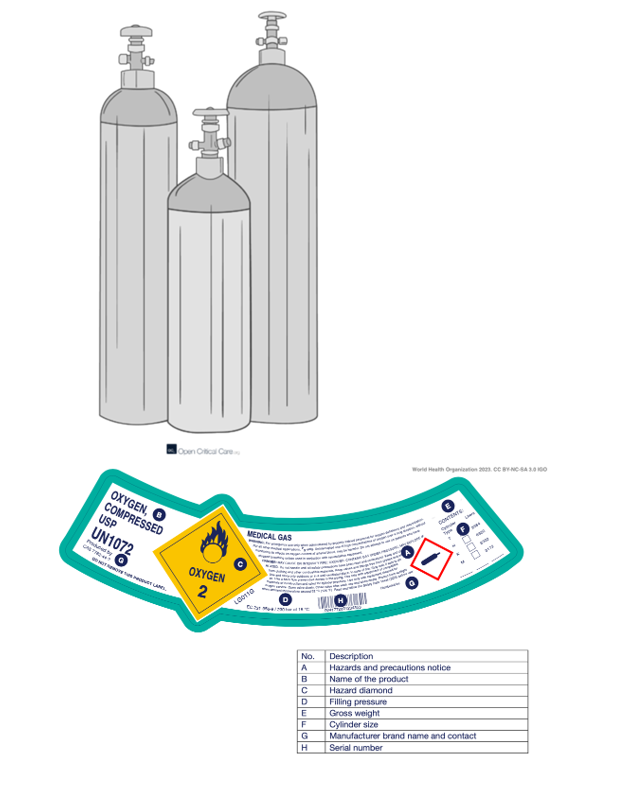
View the following supplementary YouTube video[4] shows how a cylinder of compressed medical gas can be dangerous if not handled properly: MythBusters Air Cylinder Rocket
Valves, Regulators, and Accessories
Cylinders require several accessories for safe use in clinical settings. Each cylinder has a valve that must be opened with a specialized key, hand wheel, or toggle. For valves that require a key, it is recommended to secure these to the cylinders.
For more information on cylinder regulators and valves, check out the article on oxygen connector types.
Once oxygen leaves the cylinder valve at high pressure, it must be lowered to a pressure safe for administration to a patient or an oxygen delivery device. Regulators are specialized devices used for the purpose of lowering pressure to a level where a device can be used to further control flow to the patient (see Figure 5[5]).
Important Note: It is unsafe to connect a patient directly to an oxygen cylinder without a pressure regulator.
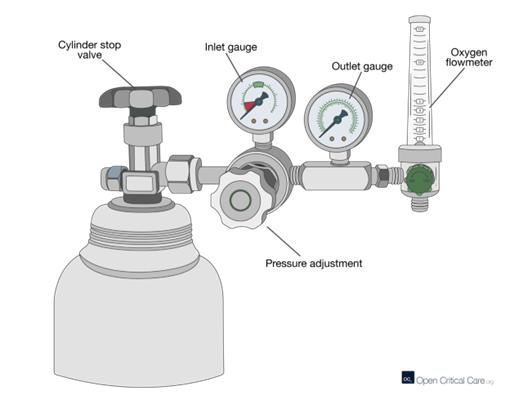
Types of Regulators
- Bourdon Gauge – The bourdon gauge is a fixed orifice regulator that has an integrated pressure reducing valve that accepts variable inlet pressure from the medical gas cylinder. Bourdon gauge regulators are only used on medical gas cylinders and they are unaffected by gravity and are not back-pressure compensated. Because these gauges measure pressure, when an obstruction to flow occurs resulting in back-pressure, the gauge will read that the patient is receiving flow when no flow is acutally being given.[6]
View the following supplementary YouTube video[7] explaining more about a Bourdon guage: Bourdon Gauge (Medical definition) | Quick Explainer Video
- Preset Regulator – A medical device that’s attached to an oxygen tank and has a preset pressure. It’s designed to control the delivery of oxygen for use with portable oxygen tanks (see Figure 6[8]).
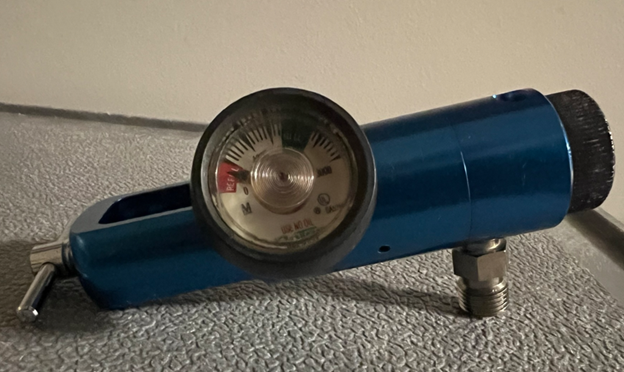
View the following supplementary YouTube video[9] on how to place a preset regulator on an oxygen tank: Regulator on an E-cylinder
Cylinder Tank Factors and Calculations
The most common cylinders used in hospital facilities are E cylinders and H cylinders. Respiratory therapists should be familiar with how to calculate how long an oxygen tank will last for patient safety. The E tank factor is 0.28 L/psig (pounds per square inch gauge), and the H tank factor is 3.14L/psig. This tank factor (“L/psig”) converts tank pressures to liters of gas. To calculate how long a cylinder’s contents will last, you should use the following equation:
Minutes remaining in cylinder = Cylinder pressure x Cylinder tank factor/Flow rate (L/min)
For more information on how to calculate cylinder duration, you can visit the Oxygen Calculator.
Example
A respiratory therapist has an E oxygen cylinder with 1500 psi remaining and patient who is on 2L of flow. The cylinder will last for 210 minutes or 3.5 hours.
1500psi x 0.28L/psi/2L = 210 mins
Pressurized Hospital Gas
In a hospital, oxygen and medical air are constantly being utilized by the respiratory therapist. The Thorpe tube is used to deliver gas, which is stored in the O2 piping in copper tubing from a liquid gas system or a compressed medical gas source. The flowmeter is placed into the wall in several ways using a form of a “Quick Connect” system (see Figures 7[10] and 8[11]).
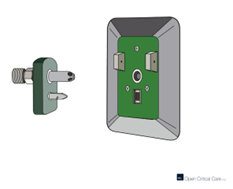
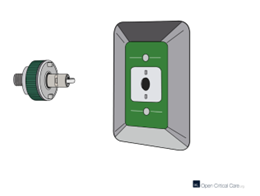
The wall system in a hospital delivers pressurized oxygen at 50 psi. A standard adult flow meter has a flow range of 0–15 liters per minute (L/min), but when fully open (also called “flush”), the flow can exceed 40 L/min.
Thorpe Tubes
Thorpe tube flowmeters are commonly used because they are easy to operate and provide accurate flow measurements when pressure compensated. They display and measure flow accurately, even if there is back pressure in the system (such as from a kinked or blocked delivery device). (See Figure 9.[12])
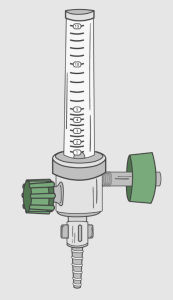
Limitations of Thorpe Tubes
- They are fragile and can break easily.
- They must be used in an upright position, as gravity affects their accuracy.
- If they are not pressure-compensated, they may display inaccurate flow when back pressure is present.
View the following supplementary YouTube video[13] explaining more about the Thorpe tube flowmeter: Thorpe Tube (Medical Definition) | Quick Explainer Video
How to Test the Thorpe Tube Flowmeter
- Connect your oxygen adapter (see Figure 10[14]) to the flowmeter and insert the flowmeter to the oxygen quick-connect.
- Attach a non-rebreather mask with oxygen tubing to the flowmeter.
- Set the flowmeter to the flush (fully open) setting. Assess the ball jumping in the flowmeter.
- Observe any changes to the reservoir bag on the oxygen mask, and note any sounds produced.
- If the Thorpe tube is working correctly, the reservoir bag should inflate.
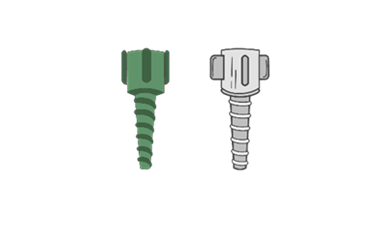
Liquid Oxygen
Most of the oxygen in a hospital is delivered to patients by tubing in the walls that come from a liquid oxygen tank system. This is from a process known as fractional distillation. (See Figures 11[15] and 12.[16])
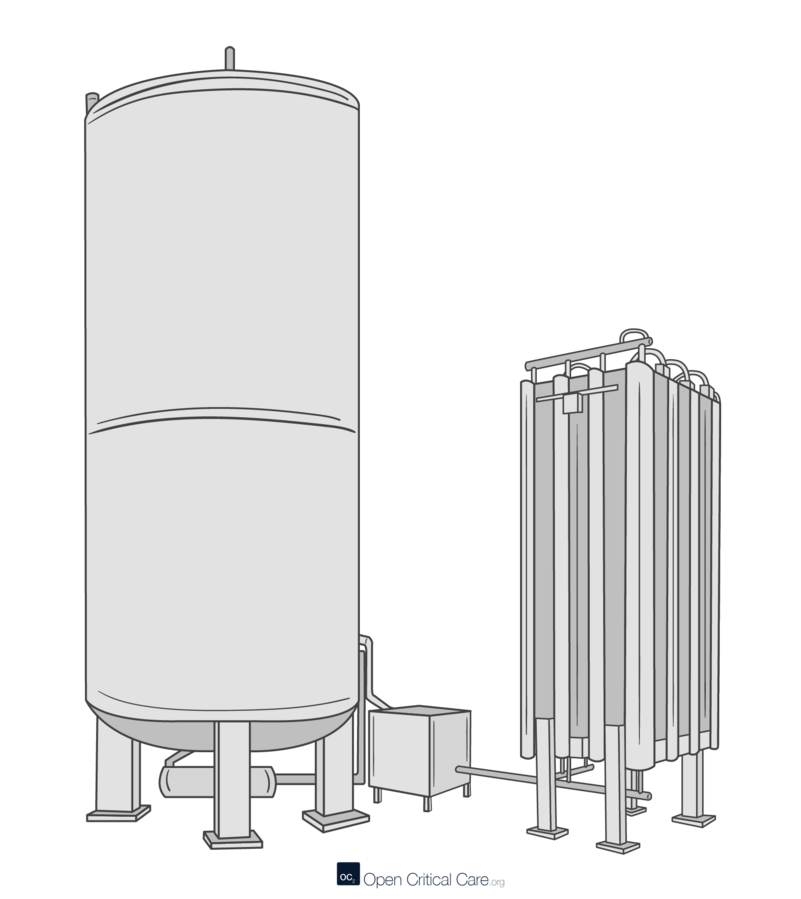
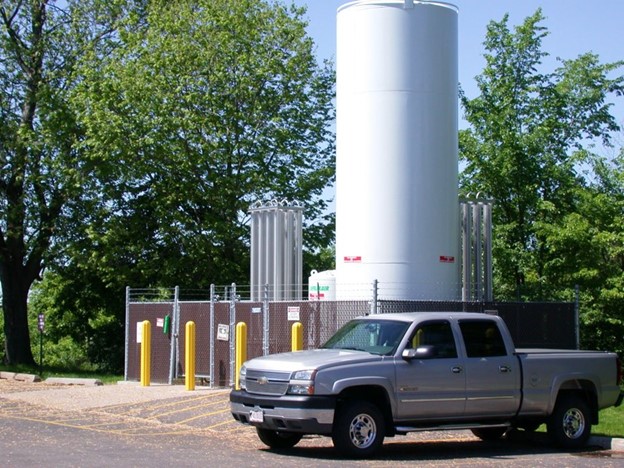
Liquid Oxygen Portable Shoulder Pack
Home-care patients may use a small, portable liquid oxygen pack, which requires special handling (see Figures 13[17] and 14[18]). Because liquid oxygen will gradually evaporate from the portable unit, always keep it in an upright position. If the unit is accidentally tipped over, you may notice hissing sounds and see oxygen vapor escaping. In this case, immediately place the unit upright and allow it to settle. Always store the pack in a well-ventilated area. Oxygen flow is typically measured in liters per minute (L/min), and the duration of a portable oxygen tank depends on the continuous flow rate.
To calculate how long the oxygen in a liquid container will last, first weigh the container. One liter of liquid oxygen weights 2.5 lbs. Multiply the weight by 344 to find the number of liters available. Then, divide this value by the patient’s required liter flow. This final figure will provide the estimated time remaining for the oxygen system[19].
Example
A liquid oxygen tank contains 3 lbs of liquid oxygen. The patient is receiving oxygen at 4L/min via a nasal cannula. How long with the liquid oxygen last?
3 lbs x 344 = 1,032 L/min available
1,032L/4 = 258 mins remaining or 4.3 hours
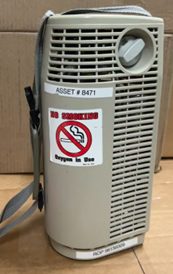
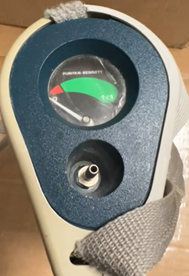
- “Oxygen Cylinder Holder” by Don Raymond, Chippewa Valley Technical College is licensed under CC BY-NC 4.0 ↵
- Doyle, G. R., & McCutcheon, J. A. (2015). Clinical procedures for safer patient care. BCcampus. https://opentextbc.ca/clinicalskills/ ↵
- “Oxygen Cylinders” and “Cylinder Labeling” by Open Critical Care are licensed under CC BY-NC-SA 4.0 ↵
- FPC CAP. (2013, April 11). MythBusters air cylinder rocket [Video]. YouTube. All rights reserved. https://www.youtube.com/watch?v=C4kb-8CjVYg ↵
- “Oxygen cylinder regulator” by Open Critical Care is licensed under CC BY-NC-SA 4.0 ↵
- Lipnick, M., Vanderburg, S., Sendagire, C., & Neighbour, R. (2023). Overview of oxygen connector types. Open Critical Care. https://opencriticalcare.org/encyclopedia/overview-of-oxygen-connector-types/ ↵
- Respiratory Therapy Zone. (2021, June 15). Bourdon gauge (Medical definition) | Quick explainer video [Video]. YouTube. All rights reserved. https://www.youtube.com/watch?v=MIDKp-d9zu8 ↵
- “Preset Regulator” by Don Raymond, Chippewa Valley Technical College is licensed under CC BY-NC 4.0 ↵
- Respiratory Therapy Educational Resources. (2017, October 3). Regulator on an E-cylinder [Video]. YouTube. All rights reserved. https://www.youtube.com/watch?v=4QLmMyuVqKc ↵
- “hemetron-NCG-Rectangle-Locking-Pin-vp3p31-768x593“ by Open Critical Care is licensed under CC BY-NC-SA 4.0 ↵
- “Ohmeda-quick-connect-oxygen-connector-zbjq22-768x593“ by Open Critical Care is licensed under CC BY-NC-SA 4.0 ↵
- “Oxygen-flowmeter-15-Side-set-to-5 LPM-ave qa8“ by Open Critical Care is licensed under CC BY-NC-SA 4.0 ↵
- Respiratory Therapy Zone. (2021, July 31). Thorpe tube (Medical definition) | Quick explainer video [Video]. YouTube. All rights reserved. https://www.youtube.com/watch?v=DFuoqhz8X8M ↵
- “barbed-christmas-tree-oxygen-adapter-wzzz3q.png” by Open Critical Care is licensed under CC BY-NC-SA 4.0 ↵
- “Liquid_Oxygen.png” by Open Critical Care is licensed under CC BY-NC-SA 4.0 ↵
- “Oxygen Tanks_Outside” by Don Raymond, Chippewa Valley Technical College is licensed under CC BY-NC 4.0 ↵
- “Portable Liquid Oxygen Tank” by Don Raymond, Chippewa Valley Technical College is licensed under CC BY-NC 4.0 ↵
- “Top View_Portable Oxygen Tank” by Don Raymond, Chippewa Valley Technical College is licensed under CC BY-NC 4.0 ↵
- Vanderburg, S., Lipnick, M., Neighbour, R., & Sendagire, C. (2024). Overview of oxygen sources. Open Critical Care. https://opencriticalcare.org/encyclopedia/overview-of-oxygen-sources/ ↵

